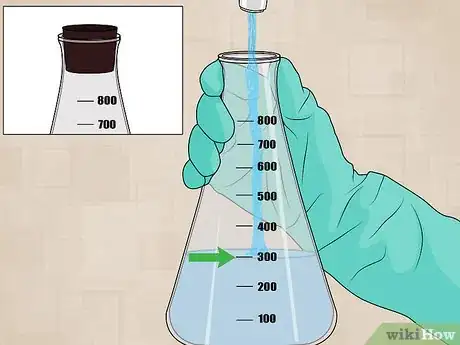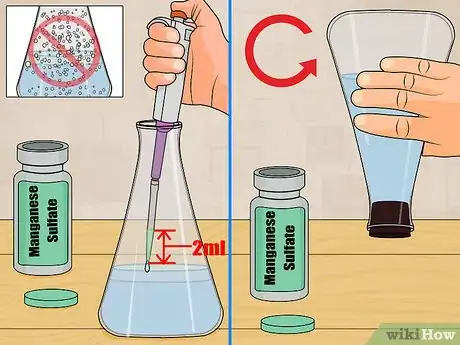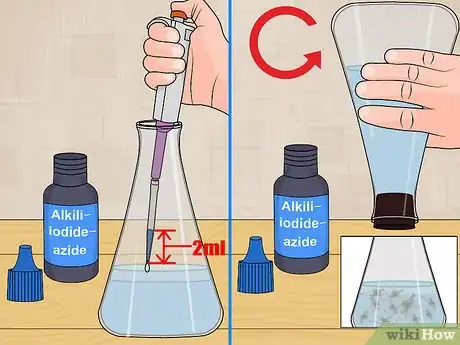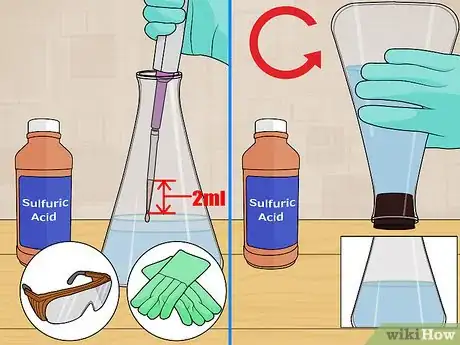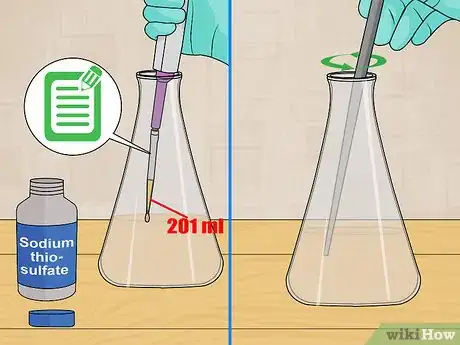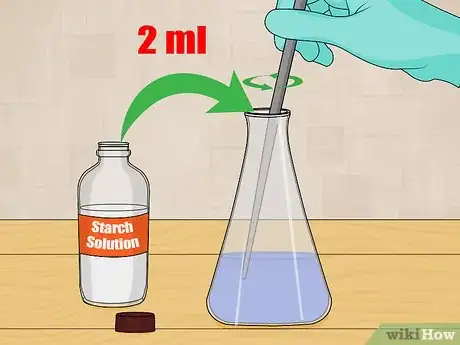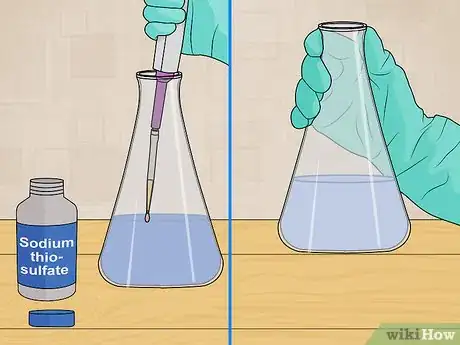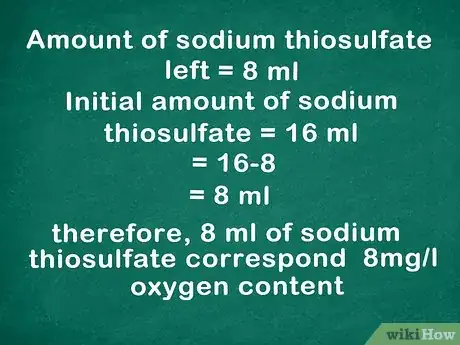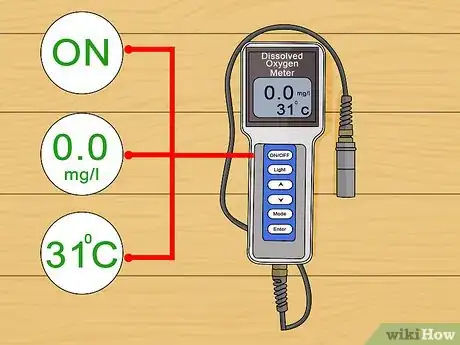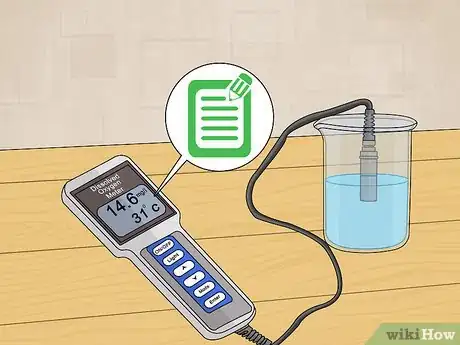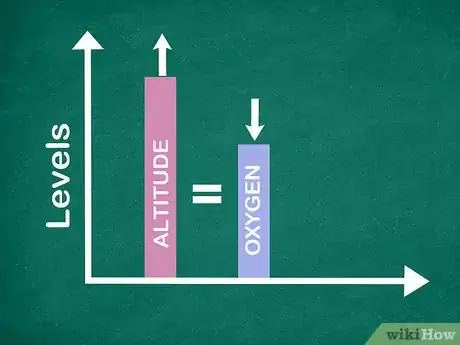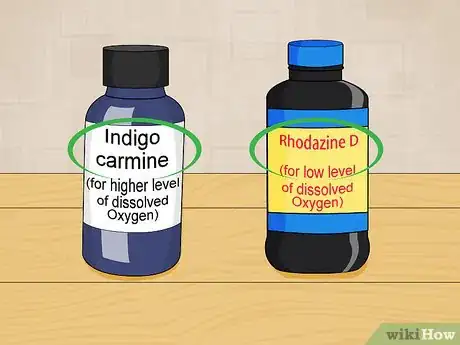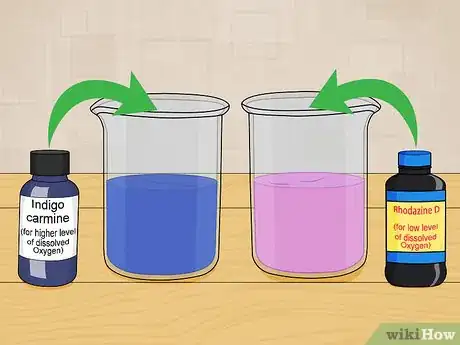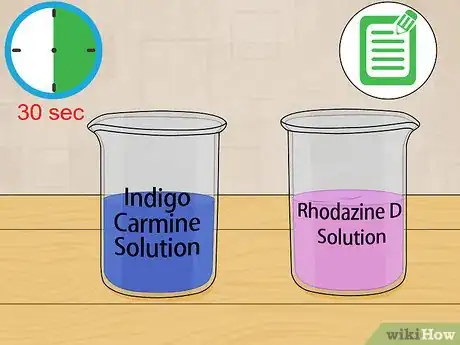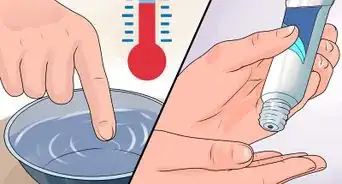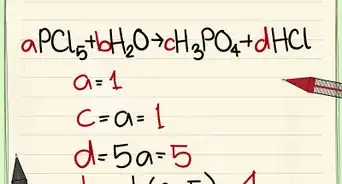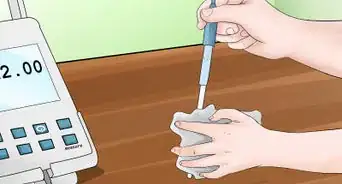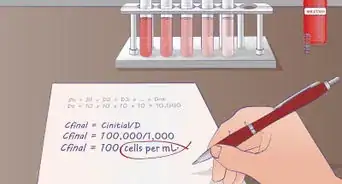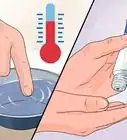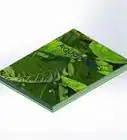This article was co-authored by Bess Ruff, MA. Bess Ruff is a Geography PhD student at Florida State University. She received her MA in Environmental Science and Management from the University of California, Santa Barbara in 2016. She has conducted survey work for marine spatial planning projects in the Caribbean and provided research support as a graduate fellow for the Sustainable Fisheries Group.
This article has been viewed 94,763 times.
In order for water to support life, there must be oxygen dissolved into the liquid. This oxygen is not part of the water molecule, H2O, but is oxygen gas, O2, dissolved in the water. There are a few ways to measure this dissolved oxygen content. One is by titration, another is with a meter, and you can also measure it using colorimetric methods, where a reactive substance responds to the oxygen levels.
Steps
Titrating the Water
-
1Gather your materials. For this measurement, you need 2 flasks with stoppers, a calibrated pipette, a graduated pipette, manganese sulfate, water, alkali-iodide-azide, sulfuric acid, sodium thiosulfate, and a starch solution.[1]
-
2Collect a sample. Take a 300 mL sample of water. This can be from a tap, a stream, a pond, or any other water source. Collect the sample in a flask with a stoppered top.[2]Advertisement
-
3Mix manganese sulfate with the water. Use a calibrated pipette to add 2 milliliters (0.068 fl oz) of manganese sulfate into the sample. Put the tip of the pipette just beneath the surface of the water before releasing the contents. Stopper your bottle and mix the manganese sulfate by inverting the bottle several times slowly.[3]
- If you drop the contents into the water they will come in contact with the air and this will introduce oxygen into the sample and alter results.
- If any air bubbles occur, then the sample is contaminated and you will need to start over.
-
4Add alkali-iodide-azide to the sample. Next, add 2 milliliters (0.068 fl oz) of alkali-iodide-azide to the sample using a calibrated pipette. The tip of the pipette should be just below the surface of the water before ejecting the contents. Stopper the bottle and mix the alkali-iodide-azide by inverting the bottle slowly several times.[4]
- If oxygen is present you will observe the formation of floc. This is an orange-ish solid that will settle in the bottom of the flask.
-
5Fix with sulfuric acid. Use a pipette to measure 2 milliliters (0.068 fl oz) of concentrated sulfuric acid. Drop the sulfuric acid into the solution. Do not place the tip of the pipette into the water. Mix the acid by inverting the flask several times. The floc should redissolve.[5]
- Wear gloves and goggles for safety when working with sulfuring acid. Avoid contact with skin and eyes. Do not ingest. Do not inhale.
-
6Titrate 201 mL of sample. Measure exactly 201 mL of sample into a new flask. Place this sample beneath a graduated pipet filled with sodium thiosulfate. Add sodium thiosulfate until the sample turns a pale yellow color.[6]
- Write down the initial amount of sodium thiosulfate in the pipet.
- Stir the solution continually as you titrate.
-
7Introduce starch solution. A starch solution will react with the iodine present in the sample to form a blue color. You only need to add 2 milliliters (0.068 fl oz) of starch solution. Stir or swirl the solution well.[7]
- Starch solution can be made by mixing water with corn or potato starch, or you can buy one premade.
-
8Continue to titrate. Once the sample turns blue, continue titrating with sodium thiosulfate. Add the titrant slowly, as one drop will make a difference at the end of the titration. You should stop titrating when the blue color is gone from the sample.[8]
- Hold the sample up against a white background in order to look for blue color.
-
9Understand the results. When the titration is complete, write down the amount of sodium thiosulfate left in the pipet. Subtract this amount from the initial amount of sodium thiosulfate to find how many mL of sodium thiosulfate you used to titrate the sample. The amount of sodium thiosulfate in mL is equal to the dissolved oxygen content in mg/L.[9]
- For example, if you used 8 mL of sodium thiosulfate, that would correspond to a dissolved oxygen content of 8 mg/L.
Using a Dissolved Oxygen Meter
-
1Calibrate the meter. Manually adjust the meter to read zero by turning the screw in the middle of the meter. Next, connect the probe and turn the meter on for fifteen minutes for optimum performance. Adjust the redline with the control knob to align with the 31 °C (87.8 °F) line and set the central line to 0.[10]
- All meters are calibrated differently. See the manufacturer’s instructions for variations that are specific to your meter.
- Meters are calibrated in Celsius not Fahrenheit.
-
2Measure a sample of water. Place the probe into a sample of water that you wish to measure. Allow the meter to stabilize. Write down your reading. Check the sample a few times to make sure the meter is calibrated.[11]
-
3Analyze the measurement. Understand that running water will have a higher dissolved oxygen content than still water. Higher altitudes mean less dissolved oxygen. Consider these things when you look at your measurement to be sure that the measurement makes sense given the sample you are taking.[12]
Estimating with Colorimetric Methods
-
1
-
2Introduce the reagent to your sample. Once you have chosen a reagent, introduce it to a sample of water. Drop the reagent into the sample of water and watch for a color change. The deeper the color, the more dissolved oxygen present.[14]
- Indigo carmine will produce a deep blue color.
- Rhodazine D will produce a deep pink color.
-
3Measure the oxygen levels by matching the colors of the solution to the key. If you are using rhodazine D, record the dissolved oxygen range promptly at 30 seconds after adding the reagent. The same holds true for measuring small ranges of dissolved oxygen with indigo carmine. If you are measuring a sample with higher levels of dissolved oxygen, wait 2 minutes and record the result.[15]
Expert Q&A
-
QuestionHow do I determine if there is a low or high level of dissolved oxygen?
 Bess Ruff, MABess Ruff is a Geography PhD student at Florida State University. She received her MA in Environmental Science and Management from the University of California, Santa Barbara in 2016. She has conducted survey work for marine spatial planning projects in the Caribbean and provided research support as a graduate fellow for the Sustainable Fisheries Group.
Bess Ruff, MABess Ruff is a Geography PhD student at Florida State University. She received her MA in Environmental Science and Management from the University of California, Santa Barbara in 2016. She has conducted survey work for marine spatial planning projects in the Caribbean and provided research support as a graduate fellow for the Sustainable Fisheries Group.
Environmental Scientist Each of the methods above provides a means of determining the level of dissolved oxygen in water. The first two will provide a numerical calculation of the level from which you can discern exactly whether it's high or low. The colorimetric approach will give you a general sense of the level of dissolved oxygen depending on the color produced by the reagent.
Each of the methods above provides a means of determining the level of dissolved oxygen in water. The first two will provide a numerical calculation of the level from which you can discern exactly whether it's high or low. The colorimetric approach will give you a general sense of the level of dissolved oxygen depending on the color produced by the reagent.
Warnings
- Dispose of all chemicals ethically and safely.⧼thumbs_response⧽
- All of these chemicals are extremely dangerous to human and animal well being. Use a lab coat, goggles, and latex gloves when performing the operation.⧼thumbs_response⧽
- Sulfuric acid is a corrosive substance. Store in glass bottles and use extra caution.⧼thumbs_response⧽
References
- ↑ https://www.umass.edu/mwwp/protocols/rivers/oxygen_river.html
- ↑ http://serc.carleton.edu/microbelife/research_methods/environ_sampling/oxygen.html
- ↑ http://serc.carleton.edu/microbelife/research_methods/environ_sampling/oxygen.html
- ↑ http://serc.carleton.edu/microbelife/research_methods/environ_sampling/oxygen.html
- ↑ http://serc.carleton.edu/microbelife/research_methods/environ_sampling/oxygen.html
- ↑ https://sciencing.com/winkler-titration-method-6076224.html
- ↑ http://serc.carleton.edu/microbelife/research_methods/environ_sampling/oxygen.html
- ↑ http://serc.carleton.edu/microbelife/research_methods/environ_sampling/oxygen.html
- ↑ http://serc.carleton.edu/microbelife/research_methods/environ_sampling/oxygen.html
- ↑ https://sciencing.com/winkler-titration-method-6076224.html
- ↑ https://sciencing.com/winkler-titration-method-6076224.html
- ↑ https://www.globalspec.com/learnmore/sensors_transducers_detectors/analytical_sensors/dissolved_oxygen_instruments
- ↑ http://www.fondriest.com/environmental-measurements/equipment/measuring-water-quality/dissolved-oxygen-sensors-and-methods/
- ↑ http://www.fondriest.com/environmental-measurements/equipment/measuring-water-quality/dissolved-oxygen-sensors-and-methods/
- ↑ http://www.fondriest.com/environmental-measurements/equipment/measuring-water-quality/dissolved-oxygen-sensors-and-methods/
About This Article
To measure the dissolved oxygen level of water with a meter, first manually adjust the meter to read zero. Next, connect the probe and turn the meter on for 15 minutes. Then, use the control knob to align the red line with the 31 degree Celsius line and set the central line to 0. Once you've finished calibrating the meter, place the probe into some water and write down the measurements on the meter. To learn how to estimate the oxygen level with colorimetric methods, keep reading!
